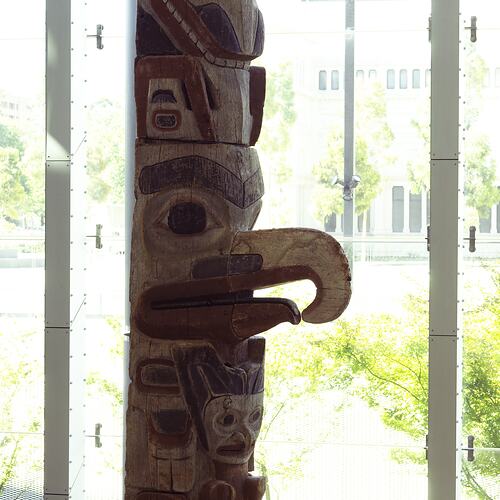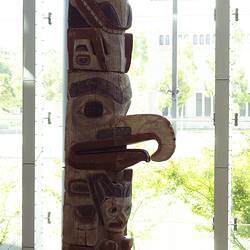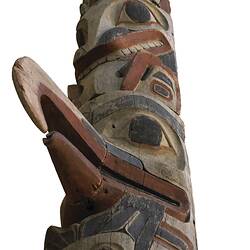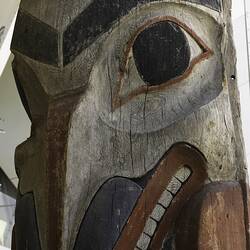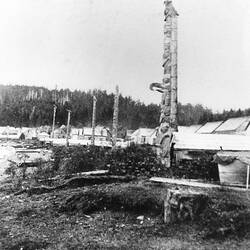Summary
This twelve metre totem pole from British Columbia, Canada, has four major iconic carvings that represent the major totems that traditionally travel through the maternal line in Haida society. Totem poles from the First Peoples Nations of northwest Canada are often up to eighteen metres in height. They were positioned in front of the homes of their owners, and this totem pole and a number of others were photographed in situ in Skidegate village in the Queen Charlotte Islands in 1901. These poles are cut from a single log of Pacific Coast Red Cedar, and are made to honour a person's achievements, eg. as a whale hunter, a great carver or speechmaker. A person who excelled in life would amass names reflecting these achievement, and gain specific rights and privileges reflecting their status. Their fame would be commemorated with the carving of a totem pole, the carvings on the pole reflecting their deeds and stories. This honour brings with it the need for a family to amass sufficient wealth often over many years to pay for a first feast when the log is felled and brought to the village, and then a second feast when the totem pole is erected. Other figures might be carved on and around the totems referencing narratives surrounding the commemoration, and the removable segmented cylinder at the top of a pole is indicative of the number of potlash feasts given by the owner and his descendants over the life of the pole.
Physical Description
A large totem pole carved from a single log of cedar wood cut into two sections. It has figures carved out of the wood: from the bottom, grizzly bear, eagle, killer whale and frog.
Significance
This pole comes from Skidegate village in the Queen Charlotte Islands in British Columbia, Canada. It was obtained in an exchange with the Field Museum in Chicago despite the report by their director, George Dorsey, that Baldwin Spencer had 'refused many offers of exchange [due to] the extreme rarity of Australian artefacts'. Objects from central Australia to the value of '100 pounds' were sent to Chicago in 1908 and the totem pole arrived in Melbourne in 1911. Charles Frederick Newcombe was the original collector of this and other totem poles at Skidegate village. He was commissioned by a number of museums in Canada, USA and UK to collect artefacts from along the British Columbia coast from the First Nations people of the Haida, Kwakiutl, Nootka and Salish, and Dorsey engaged him to collect for the then Field Columbian Museum from 1897. However it is most likely that the totem pole was collected between 1901 and 1905 along with the others from Skidgate village, which were distributed amongst museums across the world - namely to museums in Sydney (presumably to the Australian Museum), Cambridge, Kew Gardens, Liverpool and the British Museum in the United Kingdom, and Chicago, Brooklyn, Pennsylvania, the American Museum of Natural History and the University of California in the United States America. During the last one hundred years at this museum, the pole was cut into two sections in order to fit it into the store rooms, and only in 2000 were these two parts reunited when it was placed on display in the public galleries of the then newly opened Melbourne Museum. It remained there until last year and is now back in storage. The totem pole is now the focus of inquiries from the Haida Gwaii Museum at Kay LLnaggay in Canada.
More Information
-
Object/Medium
Carving
-
Maker
-
Cultural Groups
-
Locality
Skidegate, Haida Gwaii, North American North West Coast, British Columbia, Canada
-
Date Produced
-
Collector
-
Date Collected
-
Object Measurements
1100 mm (Length), 1100 mm (Width), 14900 mm (Height), 1100 mm (Outside Diameter)
-
Keywords
-
Type of item
-
Discipline
-
Category
-
Collecting Areas
